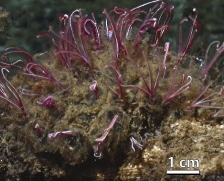Ancient Bone-Eating Worms Traced Back Over 100 Million Years

Recent research has uncovered that bone-eating worms of the genus Osedax have been thriving in the ocean for over 100 million years, dining on the remains of ancient marine creatures. This discovery, made by a team from University College London (UCL) and the Natural History Museum in the UK, reveals new insights into the evolutionary history of these unique organisms, which have adapted to an unusual diet that includes the bones of long-extinct marine reptiles.
The study, published in the journal PLOS ONE in July 2025, utilized advanced computed tomography (CT) scanning techniques to create three-dimensional models of 130 fossils. Among these, evidence of burrowing behavior was found in six fossils, attributed to seven newly identified ichnospecies from the Cretaceous period. "We haven't found anything else that makes a similar burrow to these animals," stated Dr. Sarah Jamison-Todd, a paleontologist from UCL. "The ancient bores are so similar to modern Osedax species, and we don't have body fossils to contradict us, we assume that they were made by the same or a similar organism."
Historically, Osedax species are known to inhabit ocean floors where they thrive on the carcasses of whales, extracting fats and proteins from the bones. The current research indicates that these worms not only have a long evolutionary lineage but also exhibit remarkable evolutionary stability over millions of years. This is evidenced by the similarity of boring patterns found in ancient fossils with those of contemporary species.
Dr. Marc Jones, a paleontologist at the Natural History Museum, emphasized the significance of the findings: "By using the remains of small organisms that make up the chalk itself, we were able to date the fossils to more precise time slices of the Cretaceous period. This places the evolutionary history of these organisms much earlier than previously thought."
The researchers believe there are many more undiscovered examples of boring patterns from both ancient and modern bone-eating worms. The study suggests that further scans of fossils, along with genetic studies of contemporary species, could yield even more insights into the evolutionary history of these organisms. Dr. Jamison-Todd remarked, "Finding out whether these burrows are made by the same species or are an example of convergent evolution will give us a much better idea of how these animals have evolved and how they have shaped marine ecosystems over millions of years."
The implications of this research extend beyond simple curiosity about ancient life. Understanding the dietary habits and evolutionary adaptations of Osedax worms provides valuable context for marine ecology and the role of decomposers in ocean ecosystems. As scientists continue to explore the depths of our oceans and the fossils buried within, it is likely that further discoveries will shed light on the complex history of life on Earth.
In summary, the identification of these ancient bone-eating worms not only enhances our understanding of marine biodiversity but also opens new avenues for research in evolutionary biology and paleontology. The enduring presence of Osedax worms illustrates the intricate connections within marine ecosystems that have persisted for millions of years. The future of marine research promises to uncover further mysteries of these fascinating organisms, highlighting the importance of preserving our oceans and their inhabitants.
Advertisement
Tags
Advertisement





